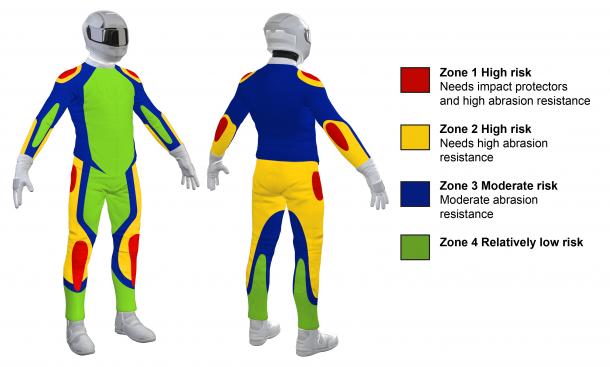
laboratory testing
Watch our video to see how motorcycle gear is subjected to scientific testing. Read a transcript.
MotoCAP safety ratings assess how well gear protects a motorcyclist in a crash, based on impact protection, burst resistance and abrasion resistance.
Test results are weighted to emphasise the need for greater protection in high risk areas as outlined in the diagram below.
Impact protection
Impact protectors are inserts that reduce the energy transferred from an impact to your body. They should protect the most exposed areas from high-energy impacts in a crash and cover the knees, hips, elbows and shoulders.
Impact protector scores include an assessment of size, position and how well the fastenings prevent the protector from moving. Gear is fitted to a human model to measure the positioning and maximum displacement of the protectors.
Impact protectors are removed from the gear and placed over an anvil that measures the energy of the impact. A 5kg flat-faced weight is dropped from 1 metre. The energy carried through the impact protector is measured. This reflects the level of protection it provides, with lower forces transmitted by well performing protectors.
Burst resistance
Gear must remain intact if it is to provide effective protection in a crash.
For the tests, a sample of the gear’s material that includes a seam is stretched and clamped over special test apparatus. Pressure is gradually applied to the seam and the test ends when the seam bursts or the maximum test pressure is reached. The maximum pressure reading determines the burst resistance score.
abrasion resistance
This test measures how long the material used in a gear could slide along a road surface before being worn away, exposing the rider’s skin to injury.
A sample is wrapped around a solid metal block on an arm, which is dropped onto an abrasive belt moving at a fixed speed and a timer started. When a hole forms in the material, a thin wire behind the material is broken, automatically stopping the timer. The longer the time taken for the material to fail, the higher its abrasion resistance.
Breathability
MotoCAP breathability ratings indicate the thermal comfort of the gear. Riders who are unable to maintain a stable core temperature have been found to experience cognitive impairment, slower reaction times, fatigue and mood deterioration, all of which can increase the risk of crashing.
Perspiration allows the human body to maintain a stable core temperature. Gear that restricts sweat evaporating may cause a rider's core temperature to rise. Sweat also needs to evaporate in cool weather, as moisture vapour building up inside gear can condense and make the rider feel cold or wet, potentially reducing their core temperature.
MotoCAP provides a breathability score based on the Relative Vapour Permeability Index. Gear with higher scores provides better insulation and allows sweat to evaporate through the material.
A moisture vapour resistance test (wet test) measures how easily sweat can escape through the gear. It uses a temperature-controlled cabinet with a sweating hotplate covered by a membrane that simulates human skin. A sample of the gear is placed over the hotplate. Heated water is injected into the hotplate, mimicking sweat forming on a rider’s skin. As the ‘sweat’ passes through the fabric to escape to the environment, more ‘sweat’ will be created to maintain the hotplate temperature. The level of ‘sweat’ that travels through the fabric is measured by monitoring the energy required to heat the hotplate.
A thermal resistance (dry heat) test measures how well gear can insulate a rider. The same equipment is used as for the wet test, but a dry plate replaces the sweating hotplate. Like the wet test, the sample is laid over the hotplate and the amount of energy required to maintain the temperature of the underlying skin membrane is measured.
Water protection
As well as the safety and breathability star ratings, gear advertised as water resistant is tested to measure the ability to prevent water penetration and scored depending on how well it performs. This helps riders make an informed decision for wet weather riding.
The water protection test method score is based on the amount of water that enters the gear and wets the underclothing of a test dummy. The test dummy is dressed in long cotton underwear (with cotton gloves and socks) under a complete set of riding gear, including helmet, gloves and boots.
The test dummy is seated on a motorcycle and exposed to twenty minutes of high pressure water sprayed at the bike headlight from two metres away. Water that gets through the gear is absorbed by the underwear, which is weighed before and after testing to determine the amount of water that has passed through.
Video transcript - MotoCAP Scientific Testing (31 seconds)
Title: MotoCAP motorcycle gear safety ratings are based on independent scientific tests
[A burst test is performed on a sample of a motorcylist jacket to record the strength of its seams. The sample is inflated under pressure until the stitching on the seam bursts.]
Title: Impact protection
[Impact protectors are removed from the gear and placed over an anvil that measures the energy when a 5kg flat-faced weight is dropped from 1m.]
Title: Thermal comfort
[A technician places a sample of gear into a test machine. The sample is placed over a hotplate, while heated water is injected into the heated plate, mimicking sweat forming on a rider’s skin. As the ‘sweat’ passes through the fabric to escape to the environment, more ‘sweat’ will be created to maintain the hotplate temperature. The level of ‘sweat’ that travels through the fabric is measured by monitoring the energy required to heat the hotplate.]
Title: Water resistance
[Water is sprayed onto a test dummy seated on a motorcycle. The test measures the amount of water that enters the gear and wets the underclothing.]
Title: Abrasion resistance
[A technician wraps a sample is around a solid metal block on an arm, which is dropped onto an abrasive belt moving at a fixed speed and a timer started. When a hole forms in the material, a thin wire behind the material is broken, automatically stopping the timer. The longer the time taken for the material to fail, the higher its abrasion resistance.]
End credits: MotoCAP Safety Ratings, choose the right gear for your ride
